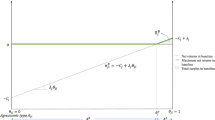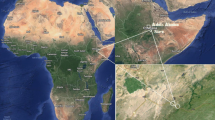Abstract
There is a growing body of literature on the costs of sequestering carbon. However, no studies have examined the interplay between farm commodity programs and carbon sequestration programs. This study investigates two dimensions of the interaction between farm commodity programs and afforestation programs, using a price-endogenous sector model of agriculture in the United States. First, this study compares the fiscal and welfare costs of achieving specific carbon targets through afforestation, with and without current farm programs. Second, it examines the welfare, fiscal, and carbon consequences of replacing existing farm subsidies, wholly or in part, with payments for carbon. Two approaches, Hicksian and Marshallian, are investigated. In the first, the sector model is used to quantify the carbon consequences and fiscal costs associated with various combinations of farm commodity and carbon sequestration programs that leave consumers and producers in the U.S. agricultural sector no worse off than under existing farm programs. The second approach focuses on the carbon and welfare consequences of various farm commodity and carbon sequestration programs that hold total program fiscal costs constant at current levels. Althouth the methodology and data are applied to the United States, the issues addressed are common in a number of developed nations, particularly within the European Union (EU). Adapting existing sector models in these nations to perform similar analyses would provide policy makers with more precise information about the nature of the trade-offs involved with second-best policies for replacing farm commodity subsidies with tree planting subsidies.
Similar content being viewed by others
References
AdamsD., R.Alig, J.Callaway, and B.McCarl (1994), ‘Forest and Agricultural Sector Optimization Model: Model Description’, Final Report to United States Environmental Protection Agency, Climate Change Division. March 23, 1994. RCG/Hagler, Bailly, Inc. PO Drawer O, Boulder CO.
AdamsD., R.Adams, J.Callaway, C.Chang, and B.McCarl (1993), ‘Sequestering Carbon on Agricultural Land: A Preliminary Analysis of Social Costs and Impacts on Timber Markets’, Contemporary Policy Issues 11(1), 76–87.
BirdseyR. A. (1992), ‘Carbon Storage and Accumulation in United States Forest Ecosystems’, USDA Forest Service General Technical Report. Northeastern Forest Experiment Station. Radnor, PA.
CallawayJ. M., DariusAdams, RalphAlig and BruceMcCarl (1994), ‘Forest and Agricultural Sector Optimization Model: Fupasom Policy Scenarios Report’, Final Report to the U.S. Environmental Protection Agency Climate Change Division. December 14, 1994. RCG/Hagler, Bailly, Inc. PO Drawer O, Boulder, CO.
ChangC., B.McCarl, J.Mjelde, and J.Richardson (1992), ‘Sectoral Implications of Farm Program Modifications’, American Journal of Agricultural Economics 74(1), 38–49.
DixonR. J., J.Winjum, K.andrasko, J.Lee, and P.Schroeder (1994), ‘Integrated Land-Use Systems: Assessment of Promising Agroforest and Alternative Land-Use Practices to Enhance Carbon Conservation and Sequestration’, Climatic Change 30, 1–23.
DudekD. and A.LeBlanc (1990), ‘Offsetting New CO2 Emissions: A Rational First Greenhouse Policy Step’, Contemporary Policy Issues 8(3), 29–42.
Englin, J. E. and J. M. Callaway (1995), ‘The Environmental Impacts of Sequestering Carbon through Forestation’, Climatic Change, forthcoming.
JustR., D.Hueth, and A.Schmitz (1982), Applied Welfare Economics and Public Policy, Prentice-Hall Inc., Englewood Cliffs, NJ.
Kommission for de Europæiske Fællesskaber (EU) (1991), Den Fælles Landbrugspolitiks Udvikling og Fremtid, Kom(91) 258 endelig udg., Bruxelles, 19 Jul., 1991: 2 Del., 32–39.
KoppR. and A.Krupnick (1987), ‘Agricultural Policy and the Benefits of Ozone Control’, American Journal of Agricultural Economics 69(5), 956–962.
Lashof, D. A. and D. A. Tirpak (ed.) (1989), ‘Policy Options for Stabilizing Global Climate’, United States Environmental Protection Agency Draft Report to Congress. Volume I: Chapters I–VI.
Marland, G. (1988), The Prospect of Solving the CO 2 Problem through Global Reforestation, U.S. Department of Energy NBB-0082. Oak Ridge, Tennessee.
McCarlB. A. and T. H.Spreen (1980), ‘Price-Endogenous Mathematical Programming as a Tool for Sector Analysis’, Amer. J. Agr. Econ. 62, 87–102.
McCarlB. (1982), ‘Cropping Activities in Agricultural Sector Models: A Methodological Proposal’, American Journal of Agricultural Economics 64 (3), 768–772.
McCarlB., C.Chang, J. D.Atwood, and W. I.Nayda (1993), Documentation of ASM: The United States Agricultural Sector Model, Texas A&M University, College Station, Texas. Draft Report.
MoultonR. and K.Richards (1990), Costs of Sequestering Carbon Through Tree Planting and Forest Management in the United States, USDA Forest Service, GTR WO-58. Washington, DC.
NortonR. and G. W.Schiefer (1980), ‘Agricultural Sector Programming Models: A Review’, European Review of Agricultural Economics 7, 229–264.
ParksP. J. and I. W.Hardie (1995), ‘Least Cost Forest Carbon Reserves: Cost-Effective Subsidies to Convert Marginal Agricultural Lands to Forest’, Land Economics 71(1), 122–136.
Richards, K. (1992), ‘Derivation of Carbon Yield Figures For Forestry Sequestration Analysis’, Draft Paper Prepared for Office of Economic Analysis, United States Department of Energy.
SamuelsonP. A. (1952), ‘Spatial Price Equilibrium and Linear Programming’, American Economic Review 42, 283–303.
SedjoR. A. and A. M.Solomon (1989), ‘Climate and Forests’, in N. J.Rosenberg, W. E.EasterlingIII, P. R.Crosson, J.Darmstadter, eds., Greenhouse Warming: Abatement and Adaptation, Washington D.C: Resources for the Future.
SegersonK. (1987), ‘Economic Impacts of Acid Rain and Ozone: Discussion’, American Journal of Agricultural Economics 69(5), 970–972.
TakayamaT. and G. G.Judge (1971), Spatial and Temporal Price Allocation Models, North-Holland Publishing Company, Amsterdam.
Trexler, M. C. (1991), ‘Minding the Carbon Store: Weighing United States Forest Strategies to Slow Global Warming’, World Resources Institute.
Author information
Authors and Affiliations
Additional information
The research reported in this paper was partially funded by the United States Environmental Protection Agency under contract number 68W90077. It does not reflect the official position of that agency. Mention of trade names does not constitute endorsement.
Rights and permissions
About this article
Cite this article
Callaway, J.M., McCarl, B. The economic consequences of substituting carbon payments for crop subsidies in U.S. agriculture. Environ Resource Econ 7, 15–43 (1996). https://doi.org/10.1007/BF00420425
Issue Date:
DOI: https://doi.org/10.1007/BF00420425




